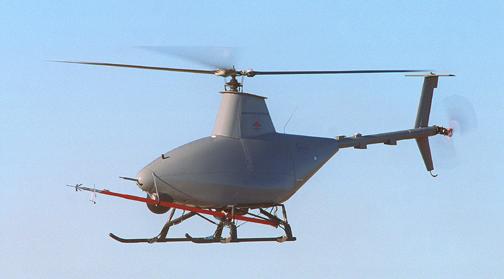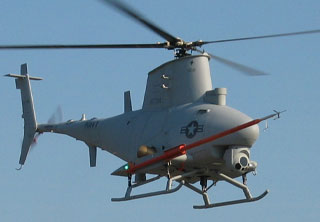Northrop Grumman RQ/MQ-8 Fire Scout
After the U.S. Navy had withdrawn from the RQ-6 Outrider program in 1998, it looked instead for a VTUAV (Vertical Take-Off and Landing UAV) to replace the RQ-2 Pioneer. The selection fell on the Northrop Grumman Fire Scout vehicle, and in February 2000 an EMD (Engineering and Manufacturing Development) contract for one Fire Scout UAV system with two air vehicles was awarded. The VTUAV, which had flown for the first time in unmanned configuration in January 2000, was designated RQ-8A. The first LRIP (Low-Rate Initial Production) contract for Fire Scout was awarded in May 2001, and the first production-representative RQ-8A flew in May 2002.
 |
| Photo: Northrop Grumman |
| RQ-8A |
The RQ-8A was based on the Schweizer Model 330SP manned light helicopter. It was powered by a derated Rolls-Royce/Allison 250-C20W turboshaft engine which drives a three-bladed rotor. The blades could be folded for compact stowage of the UAV. The Fire Scout was equipped with a GPS-based navigation system for autonomous operations, and the GCS (Ground Control Station) could control three UAVs simultaneously. The line-of-sight range of the Ku-Band TCDL (Tactical Common Datalink) was about 280 km (150 nm). The payload for the reconnaissance and targeting mission was an integrated Northrop Grumman EO/IR/LDRF (Electro-Optical/Infrared/Laser Designator & Rangefinder) system.
Fire Scout system tests, including ship-board operations from USS Denver (LPD 9), began in late 2002. Originally the U.S. Navy had announced that the Fire Scout program would be cancelled after completion of the first LRIP batch, but this decision has been rescinded and the program continued.
 |
| Photo: Northrop Grumman |
| RQ-8A |
Early into the test program, Northrop Grumman proposed an improved version called Sea Scout, based on the Schweizer Model 333 helicopter. The upgrade would include a four-blade rotor for increased payload and mission duration, and the ability to carry precision-guided air-to-surface missiles. In January 2004 the MQ-8B (designated as such in June 2005), generally similar to the Sea Scout proposal, was selected by the U.S. Army for its FCS UAS (Future Combat System Unmanned Aerial System) requirement. Compared to the RQ-8A, the MQ-8B featured a new four-blade main rotor with improved airfoils and had increased payload capacity and endurance. The U.S. Navy had selected the MQ-8B to support its LCS (Littoral Combat Ship) vessels, and the total (Army/Navy combined) requirement at that time was for up to 192 MQ-8B aircraft.
 |
| Photo: Northrop Grumman |
| MQ-8B |
The first flight of the MQ-8B prototype occurred in December 2006, and in June 2007, the U.S. Navy's MQ-8B entered low-rate initial production. Because of delays in the LCS program, the Navy tested and deployed the first MQ-8Bs on frigates, the first being FFG-8 USS McInerney. The Army, on the other hand, terminated its MQ-8B program in early 2010, leaving the Navy as the only operator of the aircraft. In 2011/12, a few Fire Scouts were deployed to Afghanistan for ISR (Intelligence, Surveillance and Reconnaissance) missions. In 2014, the MQ-8B was deployed for the first time on an LCS.
The MQ-8B had stub wings for weapons carriage, and could carry launchers for AGR-20 APKWS II laser-guided 2.75-inch rockets. In the 2013/14 time frame, the Navy integrated the Telephonics AN/ZPY-4(V)1 multi-mode maritime/overland surveillance radar with the MQ-8B. In the end, only 30 MQ-8B drones were purchased by the U.S. Navy, and the surviving aircraft were retired in October 2022.
In 2010, Northrop Grumman began the development of their Fire-X UAV, which integrated the MQ-8B's autonomous flight control system in the larger Bell Model 407 airframe. The first flight occurred in December that year. In 2012, the U.S. Navy awarded NG a contract for the production of the MQ-8C Fire Scout, based on the Fire-X concept. The MQ-8C shares payload, avionics and ship equipment with the MQ-8B, but offers significantly enhanced performance. Test and evaluation of the MQ-8C by the Navy began in 2013, with the first flight being conducted on 31 October. IOC of the MQ-8C was only achieved in June 2019.
 |
| Photo: U.S. Navy |
| MQ-8C |
A total of 38 MQ-8Cs were built for the U.S. Navy, but as of 2023, only 10 were used for operations while the rest were held in storage. In April 2024, it was reported that the Navy plans to remove the remaining Fire Scouts from service, and retire all MQ-8C assets by 2026.
Specifications
Note: Data given by several sources show slight variations. Figures given below may therefore be inaccurate!
Data for RQ-8A, MQ-8B/C:
| RQ-8A | MQ-8B | MQ-8C | |
|---|---|---|---|
| Length | 6.98 m (22 ft 11 in) | 7.30 m (23.95 ft) | 10.6 m (34.7 ft) |
| Rotor diameter | 8.38 m (27 ft 6 in) | 11.2 m (36.6 ft) | |
| Height | 2.87 m (9 ft 5 in) | 3.3 m (10.9 ft) | |
| Weight | max: 1200 kg (2650 lb) | max: 1430 kg (3150 lb) | max: 2700 kg (6000 lb) |
| Speed | 231 km/h (144 mph) | 260 km/h (160 mph) | |
| Ceiling | 6100 m (20000 ft) | ||
| Endurance | 5 h | > 8 h | 15 h |
| Propulsion | Rolls-Royce 250-C20W turboshaft; 310 kW (420 shp) | Rolls-Royce 250-C47B turboshaft; 606 kW (813 shp) | |
Main Sources
[1] Kenneth Munson (ed.): "Jane's Unmanned Aerial Vehicles and Targets, Issue 15", Jane's, 2000
[2] Tom Kaminski: "The Future is Here", article in Combat Aircraft Vol. 4, No. 6, 2003
[3] "Unmanned Aircraft Systems Roadmap, 2005-2030", Office of the Secretary of Defense, August 2005
[4] Northrop Grumman: Fire Scout
[5] Northrop Grumman:
MQ-8B Fire Scout Brochure, 2012
[6] Northrop Grumman:
Fire-X VUAS Brochure, 2015
[7] Various web resources, referenced by Wikipedia: Northrop Grumman MQ-8
Fire Scout and Northrop Grumman MQ-8C Fire Scout
Back to Directory of U.S. Military Rockets and Missiles, Appendix 2
Last Updated: 29 December 2024